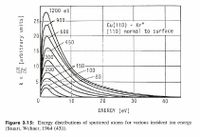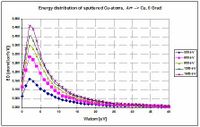Magnetron sputtering with controlled primary ion energy
a) Primary Ion Energy
The main sputter plasma of the DTM is generated by a conventional DC sputter power supply (U1). If power supply U2 is at 0 V, the DTM operates like every conventional sputter magnetron. If U2 is increased, the ions coming from the main sputter plasma will be additional accelerated towards target2. This is a nearly collisions less ion acceleration without bigger changes at the main plasma.
Dual Target Magnetron with integrated Retarding Field Analyzer at target 2
To demonstrate this effect a Retarding Field Analyzer [3] was integrated into target 2, so that it measures the ion energy distribution of the impinging ions. It could be shown, that the mean energy of the primary ions is shifted towards higher ion energies by an amount a little bit lower than U2.
A good estimation of the primary ion energy gives the following formulae:
Wion(U1,U2) = U1 - Vanode + C * U2
with:
U1: main sputter generator voltage (typ. 300 to 450 V),
Vanode: Potential of the anode (typ. 25 to 75 V),
U2: Accelerator voltage target 2,
C: Factor, approx. 0.7 to 0.9.
Ion Enegry Distribution of primary argon ions at target 2 in dependence from the voltage U2
b) Sputtered target atom energy
By this way the primary ion energy at the DTM can be operated and controlled in a range from 300 to more than 1.000 eV. In parallel the energy of the sputtered target atoms (from target 2) is increased, like shown first by [4].
Simulations with SRIM [5] show the same effect.
The corresponding mean energy of the sputtered target atoms is typically increased by 5 to 10 eV in the above primary ion energy range.
Energy spectra of sputtered copper atoms in dependence from the primary ion energy [4]
SRIM Simulation [5] of the energy distibutions of sputtered copper atoms in dependence of the primary ion energy
c) Energy of reflected sputter gas atoms
With increase of the primary ion energy also reflected neutral sputter gas atoms occur. Two cases should be distinguished:
- heavy primary ion and low weight target atoms (reflection coefficient lower 1%),
- light primary ion and heavy target atom (refelction coefficient up to 10% and more).
d) References
[3] www.jenion.de/Plasma-Analysis/
[4] Stuart R.V., Wehner G.K., J. Appl. Phys., 35, 1819, (1964),
[5] http://www.srim.org/, James F. Ziegler, TRIM – Transport of Ions in Matter

.jpg/picture-200?_=19192ff88bd)

